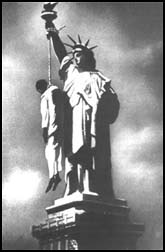he Lawyer and Due Process 
By Edward A. Malone February 18, 2001 On January 23, 1906 a white woman was raped in Chattanooga, Tennessee. A few days later Ed Johnson, a black man, was arrested as a suspect for that crime. Johnson was detained several miles away from Chattanooga for fear of mob violence. Between the time of his arrest and Johnson’s trial date, organized mobs attempted on two occasions to break into the jail and seized Johnson. On February 6, 1906, Johnson was convicted and sentenced to death. On the eve before the scheduled execution, the United States Supreme Court, however, ordered a stay of execution and allowed an appeal. On that same night, a large crowd, broke into the jail, broke into Johnson’s cell and abducted him. The deputy on duty that night at the jail simply sat by and allowed this anarchy to take place. The mob crowd mercilessly beat Johnson and dragged him to a nearby bridge. In the presence of hundreds of blood-thirsty spectators, Johnson was hung over the bridge and shot dozens of times. At this point, the reader might be thinking, “Ed, why are you relaying a story that took place almost 100 years ago?” Well, this writer believes in history. As the saying goes, if we don’t remember history, we are bound to repeat it. Hopefully, this essay will be the first of many essays on legal and social issues written by me and appearing on this website every month. Because this is black history month, I thought that it would be appropriate to write about the subject of lynching. The term lynching is derived from a practice carried out by Colonel Charles Lynch of Virginia. During the Revolutionary War, Col Lynch had a habit of seizing British Loyalists and punishing them in his front yard. Lynch and others often whipped the suspects while they were tied to a tree in front of his house.
 After the Civil War, this practice of a mob taking the law into its own hands became very popular, especially in the South. After losing the civil war and being subject to over a decade of Reconstruction, white southerners felt that they needed to “put freed blacks in their place.” During a lynching, the mob served as the police, prosecutor, judge, jury, and executioner. There was no due process of law. A lynching often began with a notice to other whites in neighboring towns, so they could witness the lynching. This created a huge spectacle with dozens, hundreds, or perhaps, thousands, watching. (I guess since there was no HBO or ESPN, these people had nothing better to do for entertainment.). The lynchers would beat their victim, usually a male, hang him on a tree or burn him on a stake. To ad insult to injury, lynchings garnered commercial sponsors. (My mention of ESPN and HBO was not really a joke.) Beginning in the 1890s, lynchers began dismembering their black victims and selling their body parts for souvenirs. One could buy a piece of dried bone for a quarter, a dried piece of the victim's liver for a dime, or a whole finger or toe for a dollar. Railway companies offered special rates and times to the crowds who wanted to view the lynchings. Newspapers publicized the events, offering dates and times. Spectators often took pictures of the lynchings and made postcards out of the pictures.

Although the excuse that many white southern politicians gave for lynchings was the protection of their white women, studies have proven that the rape or assault of white women was the excuse given for less than 25% of lynchings. John Hope Franklin wrote, "in the first fourteen years of the twentieth century only 315 lynch victims were accused of rape or attempted rape." According to Ida B. Wells, most lynchings took place because of minor offenses such as insulting a white person. Perhaps the most infamous example of lynching was the murder of Emmitt Till in 1955. Emmitt was a 14 year old black boy from Chicago visiting his relatives in Mississippi. Emmitt allegedly whistled at a white woman. For allegedly committing such an “offense”, Emmitt was shot in the head, one of his eyes was gouged out, and his head was smashed in on one side. His body was, then, dumped in a nearby river. Emmitt’s mother demanded an open-casket funeral so that the world could see the horrible and heinous crime committed against his son. Just recently, a black man in Texas, James Byrd, was lynched in 1998 by three white men. He was dragged behind a pick-up truck until he eventually died. As a testament to the progress which this country has made, two of Byrd’s murderers have been convicted and sentenced to death. The aider and abetter has been sentenced to life in prison. Although many whites were lynched, the vast majority of lynchings were against blacks. According to a study by Berea College, 72.7% of people lynched between 1882 and 1968 were black. (Click here for Lynching Statistics) Lynching is mostly a thing of the past, but due process is still under assault. The act of summararily taking away a person’s life or liberty without due process of law still takes place today. The lynch mobs have taken off their overalls and white sheets and put on blue uniforms. That’s right. Police officers today, who brutally beat and shoot innocent unarmed citizens, are the 21st century equivalent of the 19th century lynch mob. Most police officers are probably decent officers, however, way too many officers abuse their authority. And worse, most law enforcement officers turn a blind eye to the laws broken by their peers, and do nothing to stop it.

Click on picture to see video clips of police brutality
For example, on February 4, 1999, an unarmed West African immigrant with no criminal record was shot 41 times by New York City police officers and killed in the doorway of his Bronx apartment building. The excuse given by officers is that they feared for their safety. In January 1999, a Connecticut Police officer was charged with murder of an unarmed suspect. According to investigators with the State Attorney's Office, the cop used excessive force and shot the suspect in the back while he was on his knees after a foot chase. The suspect suffered a contact wound, indicating that the gun was pressed against his back 'or close to it.” The excuse the officer gave is that he believed that the suspect was either going to shoot him or stab him and that the officer discharged his weapon out of fear for his safety. In Los Angeles, police shot an unarmed, innocent man, planted a gun on him. So it seems that all a police officers has to say in response to a charge of brutality is to claim they feared for their life or safety. Who is going to contradict him? Certainly not his fellow police officers, and certainly not the dead person who the officer just killed! The purpose of presenting all of these facts is not to bash any group of people or any profession. We need good people to join the police force. The purpose of presenting these facts is to stress the importance of due process and the importance of a lawyer. The lynchings and murders that took place at the end of the 19th century and during the better half of the 20th century are vivid examples of what happens when a person accused of a crime is not accorded with procedural safeguards. Without due process of law, the awful tragedies that I just described could happen to you. If you don’t think this could happen to you, think about what Jesus said: “Inasmuch as you have done it to the least of these, my brethren, you have done it unto me.” This means that an injustice done to the very least of those in society is the same as an injustice done to our very Lord and Savior. Think about it. The people lynched in this country were hung on a tree without due process of law. Was not Jesus hung on a tree without due process of law? Therefore, it is about time that we as a society stop bashing members of the legal profession. Lawyer jokes are cute, but they are just that—jokes. The very people who bash lawyers will probably call one when they get in trouble. If you know of a little girl, for example, who wants to be a lawyer, don’t dissuade her. Don’t call her a sellout. Buy her a legal dictionary. Take her to a courtroom to get first-hand exposure to the profession. (“Law and Order” and “The Practice” is not reality, but Hollywood.) Introduce her to members of the legal profession. Lawyers serve an important function in our society, and we need to encourage good people to join that professional. If you are a witness to police brutality or misconduct, please don't intervene directly. This could cost you your life. As my father once said, “You may be right--dead right.” Try to note the names and badge numbers of the officers as well as the police car number. Round up witnesses if possible, and get a camera if available. Call the FBI as well as the local police or State’s Attorney’s office. |


No comments:
Post a Comment